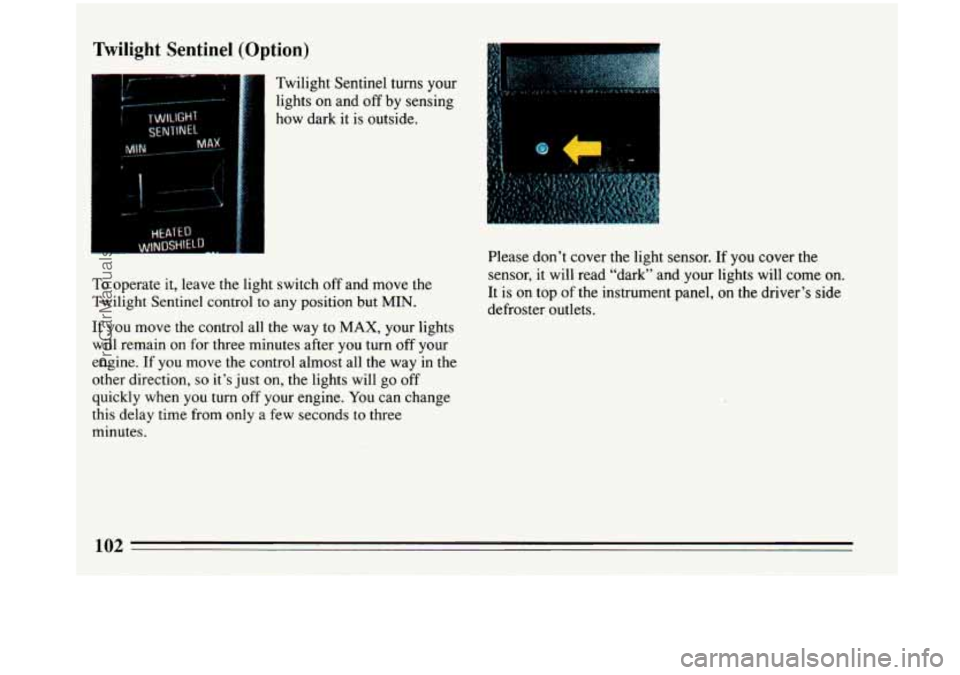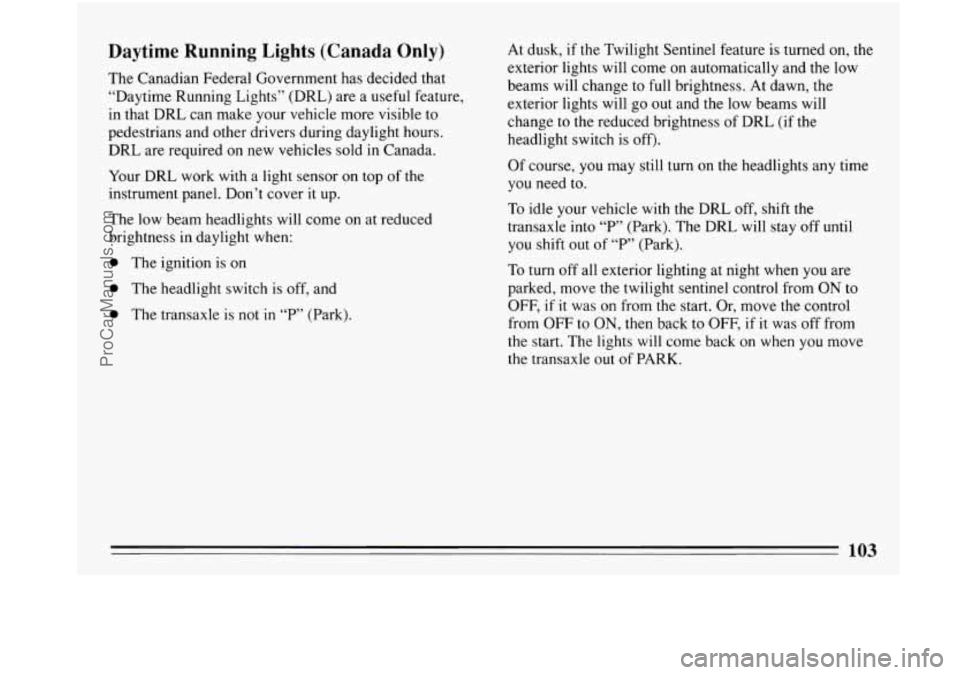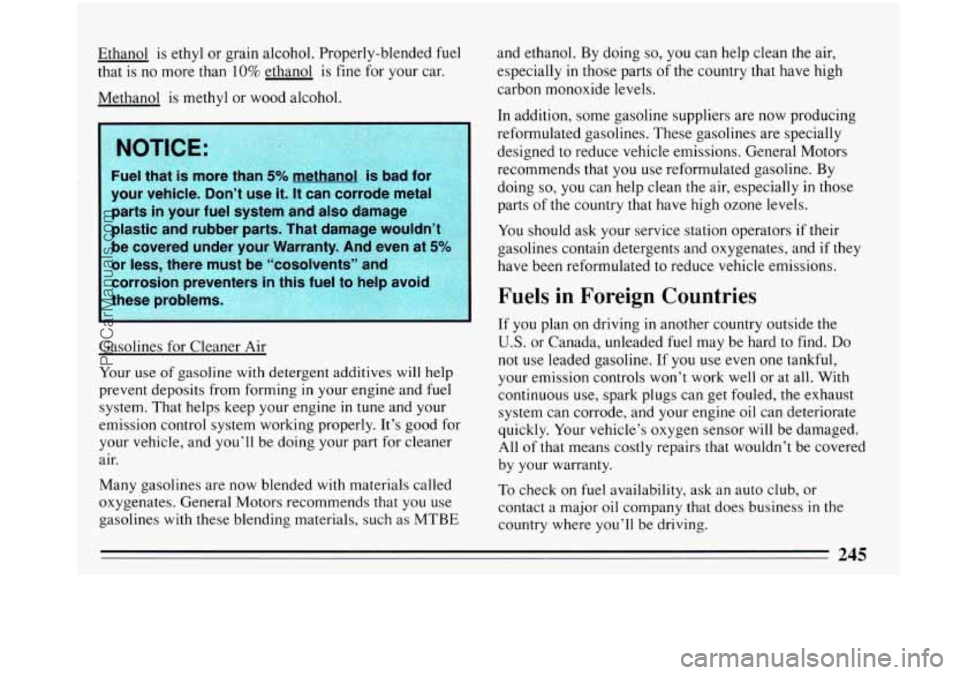sensor BUICK PARK AVENUE 1993 Owners Manual
[x] Cancel search | Manufacturer: BUICK, Model Year: 1993, Model line: PARK AVENUE, Model: BUICK PARK AVENUE 1993Pages: 340, PDF Size: 18.17 MB
Page 39 of 340

What makes an air bag inflate?
In a frontal impact of sufficient severity, sensors
strategically located
on the vehicle detect that the
vehicle is suddenly stopping as a result
of a crash. These
sensors complete an electrical circuit, triggering a
chemical reaction
of the sodium azide sealed in the
inflator. The reaction produces nitrogen gas, which
inflates the cloth bag. The inflator, cloth bag, and related
hardware are all part of the air bag inflator module
packed inside the steering wheel.
How does an air bag restrain?
In moderate to severe frontal or near-frontal collisions,
even belted occupants can contact the steering wheel.
The air bag supplements the protection provided by
safety belts. Air bags distribute the force
of the impact
more evenly over the occupant’s upper body, stopping
the occupant more gradually. But air bags would not
provide protection in many types
of collisions, including
rollovers and rear and side impacts, primarily because
an occupant’s motion is not toward the air bag. Air bags
should never be regarded as anything more than a
supplement
to safety belt protection in moderate to
severe frontal and near-frontal collisions.
What will you see after an air bag inflation?
After the air bag has inflated, it will then quickly
deflate. This
occurs so quickly that some people may
not even realize that the air bag inflated. The air bag will
- not impede the driver’s vision or ability to steer the
vehicle,
nor will it hinder the occupants from exiting the
vehicle. There will be small amounts
of smoke coming
from vents in the deflated air bag. Some components of
the air bag module in the steering wheel hub may be hot
for
a short time, but the portion of the bag that comes
into contact with you will not be hot to the touch. The
nitrogen gas used to inflate the air bag will have vented
into the passenger compartment, and the bag will be
deflated within seconds after the collision. Nitrogen
,makes up about
80% of the air we breathe and is not
hazardous. As the nitrogen vents from the bag, small
particles are also vented into the passenger
compartment.
37
ProCarManuals.com
Page 104 of 340

Twilight Sentinel (Option)
Twilight Sentinel turns your
lights on and off by sensing
how dark it is outside.
To operate it, leave the light switch off and move the
Twilight Sentinel control to any position but
MIN.
If you move the control all the way to MAX, your lights
will remain on for three minutes after you turn off your
engine.
If you move the control almost all the way in the
other direction,
so it’s just on, the lights will go off
quickly when you turn off your engine. You can change
this delay time from
only a few seconds to three
minutes. Please don’t
cover the light sensor.
If you cover the
sensor, it will read “dark” and your lights will come on.
It is
on top of the instrument panel, on the driver’s side
defroster outlets.
ProCarManuals.com
Page 105 of 340

Daytime Running Lights (Canada Only)
The Canadian Federal Government has decided that
“Daytime Running Lights” (DRL) are a useful feature,
in that DRL can make your vehicle more visible to
pedestrians and other drivers during daylight hours.
DRL are required on new vehicles sold in Canada.
Your
DRL work with a light sensor on top of the
instrument panel. Don’t cover it up.
The low beam headlights will come on at reduced
brightness in daylight when:
0 The ignition is on
0 The headlight switch is off, and
0 The transaxle is not in “P” (Park). At
dusk, if the Twilight Sentinel feature is turned on, the
exterior lights will come
on automatically and the low
beams will change to
full brightness. At dawn, the
exterior lights will go out and the low beams will
change to the reduced brightness
of DRL (if the
headlight switch is off).
Of course, you may still turn on the headlights any time
you need to.
To idle your vehicle with the DRL off, shift the
transaxle into
“P” (Park). The DRL will stay off until
you shift out of “P” (Park).
To turn
off all exterior lighting at night when you are
parked, move
the twilight sentinel control from ON to
OFF, if it was on from the start. Or, move the control
from OFF to
ON, then back to OFF, if it was off from
the start. The lights will come back
on when you move
the transaxle out
of PARK.
ProCarManuals.com
Page 247 of 340

Ethanol is ethyl or grain alcohol. Properly-blended fuel
that is no more than
10% ethanol is fine for your car.
Methanol is methyl or wood alcohol.
Fuel that is more than 5% methanol is bad for
your vehicle. Don’t use it.
It can corrode metal
parts in your fuel system and also damage
plastic and rubber parts. That damage wouldn’t be covered under your Warranty. And even at
5%
or less, there must be “cosolvents” and
corrosion preventers in this fuel to help avoid
Gasolines for Cleaner Air
Your use
of gasoline with detergent additives will help
prevent deposits from forming
in your engine and fuel
system. That helps keep your engine in tune and your
emission control system working properly. It’s good for
your vehicle, and you’ll be doing your part for cleaner
air.
Many gasolines are now blended with materials called
oxygenates. General Motors recommends that you use
gasolines with these blending materials, such as MTBE and ethanol.
By doing
so, you can help clean the air,
especially
in those parts of the country that have high
carbon monoxide levels.
In addition, some gasoline suppliers are now producing
reformulated gasolines. These gasolines are specially
designed to reduce vehicle emissions. General Motors
recommends that you use reformulated gasoline. By
doing
so, you can help clean the air, especially in those
parts of the country that have high ozone levels.
You should ask your service station operators if their
gasolines contain detergents and oxygenates, and if they
have been reformulated to reduce vehicle emissions.
Fuels in
Foreign Countries
If you plan on driving in another country outside the
U.S. or Canada, unleaded fuel may be hard to find. Do
not use leaded gasoline. If you use even one tankful,
your emission controls won’t work well or at all. With
continuous use, spark plugs can get fouled,
the exhaust
system can corrode, and your engine oil can deteriorate
quickly. Your vehicle’s oxygen sensor will be damaged.
All
of that means costly repairs that wouldn’t be covered
by your warranty.
To check on fuel availability, ask an auto club, or
contact a major oil company that does business
in the
country where you’ll be driving.
245
ProCarManuals.com